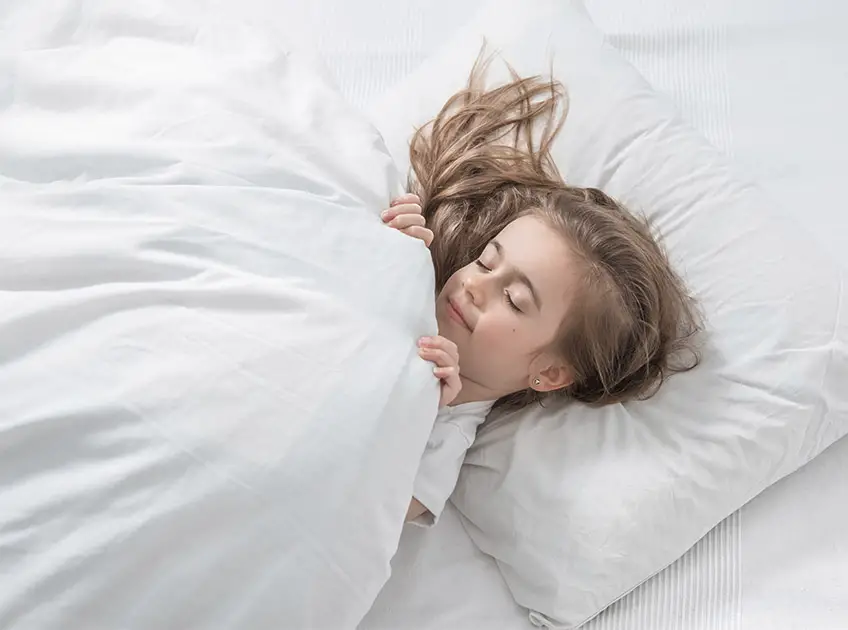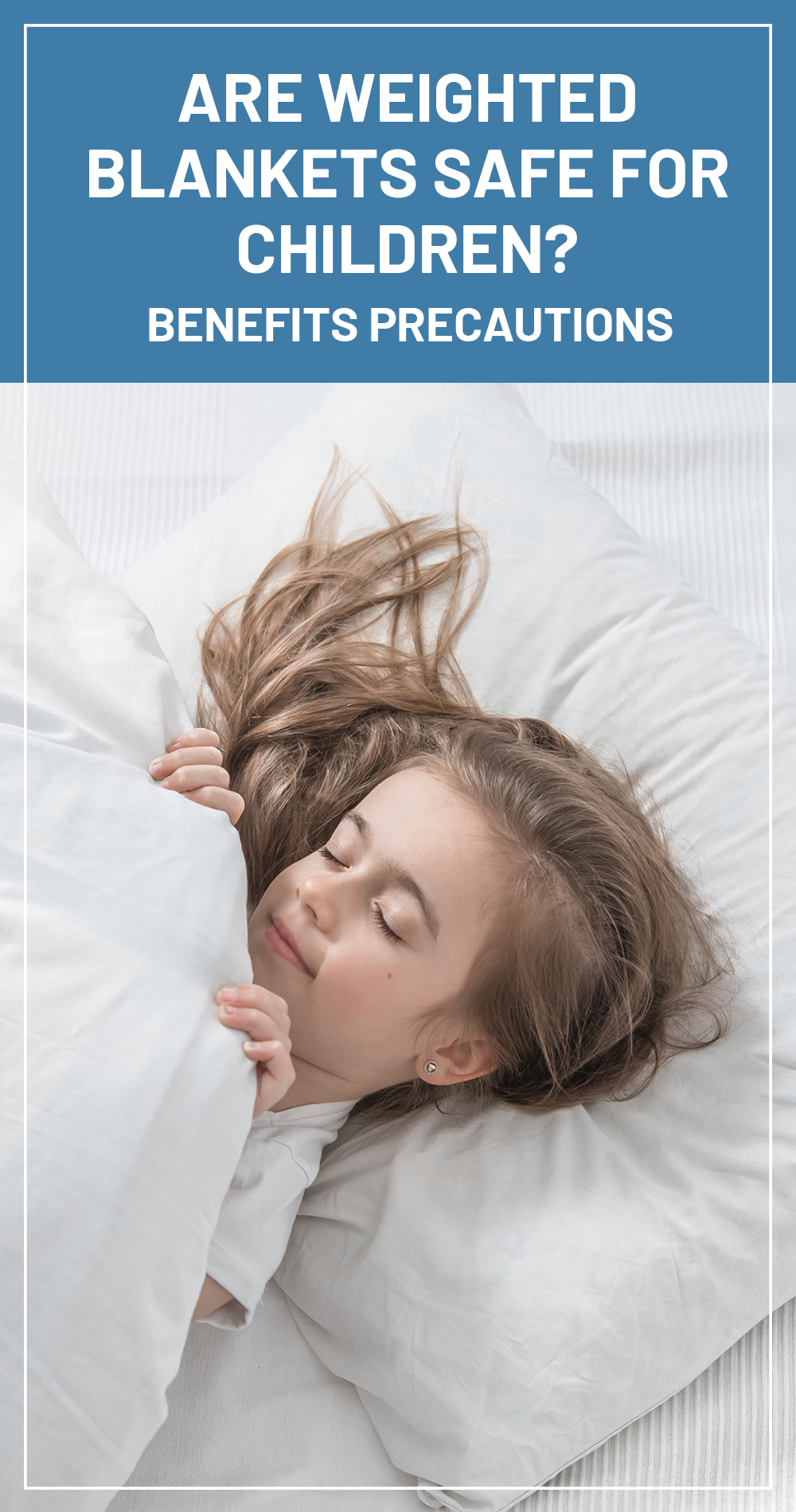
Important: This article is for informational purposes only. Please read our full disclaimer for more details.
If your child has trouble sleeping, you may look for solutions such as using weighted blankets for kids. These blankets are known to instill a sense of relaxation that might help your child sleep better. They appear similar to regular blankets but are comparatively heavier. Although sleeping under a heavy blanket might sound peculiar, it could be soothing and relaxing for some people. The pressure distributed evenly gives your body the right amount of extra weight, giving you a snuggling effect. It could help reduce anxiety and stress in children, enabling better sleep quality in the long run.
This post explains the features, potential benefits, and types of weighted blankets for children.
What Is A Weighted Blanket?

A weighted blanket is similar in design to a regular blanket and made from similar materials, such as fleece, cotton, polyester, or chenille. But, what makes it different is the filling inside it. The blanket could be stuffed with various fillers, such as steel beads, micro glass beads, weighted discs, or plastic pellets. These fillers are woven into the fabric, so its weight is evenly distributed across the blanket. The uniform weight distribution performs a ‘pressure therapy’ that could help a child relax and fall asleep easily.
Are Weighted Blankets Safe For Children?

Weighted blankets are generally considered safe for children, but it is best to consult a pediatrician or an occupational therapist before buying one for your child. These blankets are often designed for children with mental health conditions and may not be suitable for a child with no issues.
Each blanket is designed to suit children of a certain age group mentioned on the packaging. You must also check the weight and length of the blanket. Do not provide a weighted blanket to children younger than two years since they might feel suffocated under the weight and may not be able to push the blanket off them. A weighted blanket might also not be suitable for children with limited mobility.
Benefits Of Using Weighted Blankets For Kids
Weighted blankets may provide the following benefits to children.
1. Ease Anxiety
Anxiety is the constant feeling of worry and restlessness with fear of some untoward incident in the future. It may cause the heart to beat faster and the breathing to become shallower. Constant anxiety could adversely affect various systems of the body, including the nervous and digestive systems.
A study noted that individuals with psychiatric issues who used weighted blankets displayed a reduction in distress and anxiety. While there is no research on its effects on children, a weighted blanket might have similar effects on children with anxiety or related conditions. The positive effects of the blanket could be attributed to its weight. A weighted blanket exerts physical pressure on your child’s body and nerves, thus reducing anxiety and inducing a sense of peace and calm.
2. Decrease Restless Leg Syndrome
Restless leg syndrome is a sleep disorder characterized by tingling sensations in the leg that aggravate at night. It disturbs peaceful sleep and can lead to insomnia. Children may repeatedly move their legs during sleep to ease the tingling sensation.
A weighted blanket puts pressure on the legs and overrides the tingling sensation and discomfort, thus helping the child sleep better. The syndrome is often associated with anxiety, and weight blankets help with it, too.
3. Help with ADHD
Children with ADHD (attention deficit hyperactivity syndrome) find it difficult to sit still and focus on one thing at a time. They get distracted easily, and the lack of attention could affect their sleep as well. Children with the syndrome may find comfort with a weighted blanket.
A weighted blanket exerts pressure on the body, which could boost serotonin levels, a neurotransmitter that creates a sense of calmness. It may curtail hyperactivity and make it easier for the child to fall asleep easily. The constant sense of touch could also hold the attention of the child and make them sleep better.
4. Help with Autism
A study noted that children with autism spectrum disorder (ASD) tend to prefer weighted blanket over regular blanket despite the blanket not affecting their quality of sleep. It might be that a weighted blanket helps children with ASD feel calm, secure, and the constant pressure may help ease their anxiety, although more research is needed to examine these possibilities.
5. Help with Post-Traumatic Stress Disorder (PTSD)
Children with PTSD might feel unusually anxious, which affects their ability to calm down and sleep. The child may also have other sleep-related problems, such as insomnia and nightmares. Research indicates that a weighted blanket could help individuals with PTSD through pressure therapy. The deep pressure exerted by the blanket may reduce cortisol, the stress hormone, and make the child feel calm and relaxed.
Types Of Weighted Blankets
Weighted blankets are designed differently for children and adults. Some blankets can even be customized based on your child’s requirements. The following are some of the common types of weighted blankets available for children.
1. Infused weighted blanket: It comes with pellets or discs woven between two fabric layers, ensuring that the weight is distributed evenly. It is easy to fold and store.
2. Pocket weighted blanket: This blanket features small square pockets stitched on it to hold the pellets or other types of fillers.
3. Wearable weighted blanket: A wearable blanket is like a sleeping bag that your child can wear. It is available in different designs.
Precautions To Take When Using A Weight Blanket
Weighted blankets can be extremely helpful but only when used with caution. Here are some precautions you can keep in mind when using this blanket for children.
- A weighted blanket should only be used when recommended by a pediatrician or pediatric sleep specialist. Do not self-diagnose your child and get a weighted blanket simply because they do not sleep well.
- Ensure that your child feels comfortable in it. If they experience any discomfort, discontinue its use.
- The size and weight of the blanket should be according to your child’s weight and age. Do not give them oversized blankets as they can get entangled in it.
- When using for the first time, it would be worthwhile to keep a watch on the child to look for any signs of distress or suffocation for at least the first few hours. Alternatively, the child could also use the blanket for the first time while having a day time nap to make your supervision easy.
Features To Look For In A Weighted Blanket
Brands offer different types of weighted blankets with various features. Below are the basic features you should check before buying one for your child.
1. Fabric: Weighted blankets could be made of a variety of materials, such as fleece, cotton, chenille, mink, and even waterproof material. You can pick the one your child would find most comfortable.
2. Fillers: You can select the filler based on its purpose and weight. You can talk to your child’s doctor to select the one most suited for your child.
3. Weight: A good weighted blanket provides an equal distribution of weight. Also, the weight should not be burdening for your child. The ideal weight of the blanket should be around 10 percent of your child’s body weight. It could also be slightly heavier or lighter depending on your child’s preference.
4. Washable: Check for the washing procedure recommended by the seller. Opt for the one that is washable in a machine. Ensure that you wash it as per instructions to avoid damaging the blanket.
Weighted blankets could help reduce anxiety in children and lead to better sleep. However, it is not a cure for any condition or disorder. It may only help alleviate symptoms or may make them manageable. Consider it a medical aid that works well with treatment recommended by a doctor. In case you feel it might help your child, consult a doctor before using it.
Related Article
- Child Counselor In Mumbai – top 10
- 25+ Tips for Hiking With Kids And Benefits
- 5 Health Benefits of Broccoli For Babies
- Is Epsom Salt Bath Safe for Babies?
- Lemon for Babies: Age to Introduce, Benefits And Precautions
- Shea Butter for Babies: Is It Safe? Benefits & Precautions
- Why Do Babies Smile in Their Sleep? The Sweet Science Behind Sleepy Grins
- Is Coconut Oil Safe For Babies To Eat
- Why Does a Child Need Carbohydrates?
- 9 Importance of Vitamin D for Children
- 5 Benefits of Sleep Meditation For Kids
- 4 Health Benefits of Avocado For Kids
- Omega-3 for Kids: 11 Health Benefits
- Vitamin C For Kids: Why Do They Need It, Benefits and Side Effects
- How to Swaddle a Baby: How To Do It And Benefits
- Lovies For Babies: Safety, How And When To Introduce Them
- Friendship Day For Kids – History, Songs & Activities
- 35+ Cutest Box Braids Hairstyles for Kids for Stylish Look
- 36 Beautiful Happy Teacher’s Day Wishes & Quotes From Kids
- 6 Amazing Friendship Day Gifts & Card Ideas For Kids
- Rock Climbing For Kids: Benefits, Types And Tips
- Top 18 Simple and Easy Beautiful Mehndi Designs For Kids
- 25+ Ways to Praise Kids – How It Boost Self Esteem?
- 20 Most Festive Thanksgiving Songs For Kids
Image Credit: freepik
















